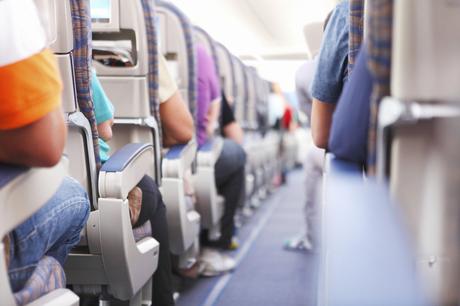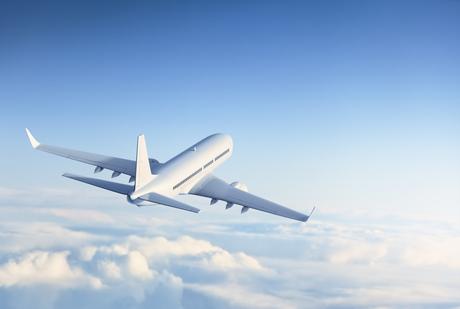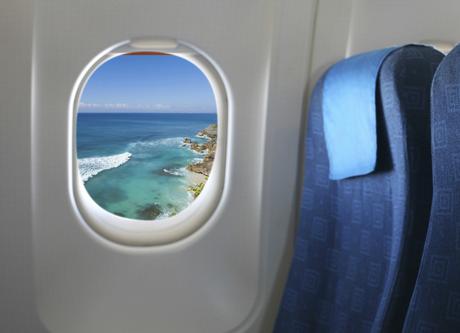
Some say it’s not the destination; it’s the journey that matters.
However, for air travelers, that’s rarely the case these days, particularly when you take into consideration the fact that we seem to be living in an era of The Incredible Shrinking Legroom. These days, many view air travel as a necessary evil; they just want to get to their destination as soon as possible.
While airlines maintain that legroom on their planes hasn’t gotten smaller, that’s something of a technicality. Over the last few years the “standard” seat pitch has decreased from 33 to 34 inches to something closer to 31 inches, causing all of us to fold ourselves up just a little more tightly. So, yes, it would certainly seem that there’s less room for your legs.
Seat pitch, a technical term used by airlines, is the distance between the back of your seat and the back of the seat in front of you. This measure includes your legs as well as the depth of the seatback structure, cushions and the tray table. Many airlines reported their seat pitch has declined due to furnishing their planes with high density seat backs that are thinner than older padded seat backs.
Doing this gave airlines some extra room on their planes. They used this extra space to put more seats or move the space up a class or two. These “improvements” reportedly didn’t take away any legroom.
But, the fact remains that you have very little room when you take your seat.
This is something Jim Curley knows all too well.
When he boards a plane, he already knows he’s going to be uncomfortable. Maybe it’s a long flight or maybe he couldn’t get the seat he wanted. But those are only exacerbating factors, because Curley is 6’6” tall.
So how does someone this tall get comfortable on a flight?
“There’s not much I can do. Once you kind of fit yourself in, my strategy is to find a good spot and stay there. I don’t try to roll my neck or things like that like some people do. It’s more about fitting into my seat, positioning myself into a spot that is the least uncomfortable until I can walk around,” says Curley, a Chief Information Officer for a chemical company in Philadelphia.
This was a strategy Curley developed over time. Throughout the past 10 years, he has, on average, traveled about 10 to 15 times per year. In fact, there was one year he was on a plane nearly every week. And these weren’t short little flights – some were from New York to Singapore, a 16-hour flight. Some of his trips were back and forth to Europe –a six-and-a-half hour flight there and an eight-hour flight home.
No matter where you’re flying or which airline is taking you there, the fact of the matter is that you won’t just be uncomfortable in your seat – your health may actually at risk.
Aches and pains right away
When you’re sitting on a plane for several hours, you’re going to feel some immediate effects.
“With very little leg room, some of the things people may experience are the stiffness for having to sit in a position without moving for a long time. You can definitely develop some back pain, some neck and shoulder pain,” says Sandra Praniewicz, a physical therapist at Sinai Hospital of Baltimore.
Praniewicz’s colleague Curtis Cunningham, a physical therapist and the manager for outpatient rehabilitation at Sinai Hospital of Baltimore, agrees.
“We weren’t built to sit for as long as we sit. So many people spend the whole day in an office sitting in a chair and then sit in an even smaller chair on a plane. The immediate effects are mostly stiffness and postural things from the ‘one size fits all’ airplane seats, or the ‘one size fits none,’” he jokes.
These aches and pains are all too familiar to Curley.
“With my legroom, I have to sit up as tall as I can in the seat. My butt has to be against the back of the seat just to have my knees be able to fit, and even with that, they touch the seat in front of me,” he says of sitting in coach or economy class.
But that’s not the most uncomfortable part for him.
“There’s absolutely no where to put your head. When I’m sitting that tall and upright in the seat, there’s no head rest. You can’t sleep on overnight flights because you can’t rest your head on anything. And if I’m sitting there too long, it starts to bother my lower back,” he says.

More serious issues, over time
For frequent fliers and people who regularly sit on long flights, they may need to worry about more than cramped legroom causing aches and pains.
Sitting for long periods of time, such as the time spent on long flights, can increase the risk of deep vein thrombosis (DVT) and pulmonary embolism.
“Deep vein thrombosis and pulmonary embolism can occur during any type of travel. People traveling by any mode – car, plane or train – have an increased risk of deep vein thrombosis – it’s something that really all travelers need to pay attention to,” says Dr. Mary Cushman, of the University of Vermont and an American Society of Hematology (ASH) spokesperson on blood clots.
The risk, she says, tends to relate to the duration of travel. Traveling on a flight that is more than four to six hours, or even 10 to 12 hours, especially on a regular basis, increases that risk.
“The human body isn’t meant to sit in the same position for a long period of time, that’s why we get stiff and sore. But when your knees are bent, your normal circulation is disrupted and it changes the way the blood flows,” Cunningham says.
“Imagine a pipe with water flowing through it and the water has to flow upward instead of downward. And then imagine the pipe has a flimsy wall. In order to get the blood to flow upward, you need the muscles in your legs to work to push it up,” she says.
The veins in your legs have valves that shut behind the blood after it flows up the leg so none can flow back down. But when you’re sitting for prolonged periods of time, the blood is flowing more slowly, which can cause it to clot.
“Once the blood clots, it’s like having a clogged drain. When that happens, swelling can occur, fluid can kind of buildup and leak out,” Dr. Cushman explains. Deep vein thrombosis is painful – the swelling and inflammation can cause pain and achiness, but there’s a bigger danger associated with this condition.
“Little pieces of the clot can break off and they travel through the normal blood flow, up to the right side of the heart, where it gets pumped into the lungs,” she says. When a clot gets into the lungs and blocks a blood vessel, that’s a pulmonary embolism.
This can be deadly, which is why it’s so important to be on the lookout for signs and symptoms of a pulmonary embolism and seek medical attention if they occur.
With DVT, classic symptoms include swelling, aching in the calf or thigh, red streaks or pinkish discoloration on the legs, and swelling in one leg.
“[Swelling] doesn’t usually occur in both legs – it’s unusual to develop clots in both legs at the same time,” says Dr. Cushman.
When it comes to pulmonary embolism, which is a complication of DVT, the symptoms may be trickier to identify, even for your doctor.
“It can be asymptomatic if it’s a small clot. But, a person can have sudden death if it’s a large clot,” Dr. Cushman says.
Common symptoms of pulmonary embolism include an unexplained, sudden onset of shortness of breath, chest pain or discomfort that gets worse when you take a deep breath or cough, feeling lightheaded or dizzy, fainting, a rapid pulse or coughing up blood.
While these conditions rightfully sound scary, Dr. Cushman says traveling only causes a very slight increase in the risk of developing them. People with a predisposition for clots, those who have recently had a surgery, people who are obese, are on birth control or hormone replacement therapy, or cancer patients going through chemotherapy are all at risk of DVT and pulmonary embolism.

What can you do?
No longer flying or not traveling aren’t realistic answers to the health complications associated with flying. But there are things you can do to lessen the risk and generally feel more comfortable on your next flight.
Experienced flyer Curley has some tips he’s picked up along the way.
“I tend to sit in the aisle seat,” he says. This is not only so he can have a little bit more room to spread his legs, but also because it makes it easier to get out of his seat.
“In the case of making last minute reservations, and you are in the middle or window seat, you’re kind of stuck having to ask others to move so you can get up,” he says.
And then, of course, you could opt for a better section of the plane.
“I’ll always do the option of preferred seats. If it’s a short flight, an hour plane ride, the legroom is no big deal. But if I’m going farther, like the West Coast or Europe, I’ll always upgrade to preferred seating and if it costs me extra money, it costs me extra,” Curley says.
According to Praniewicz, you can also try to sit in the emergency exit row where there’s more legroom or even in the seats behind this row since the emergency row seats don’t recline.
Prepare for your flight by doing some gentle walking around the airport if you have time, she says.
“Get up and move around when you get to the airport. And, if you have time, move and stretch out your calf muscles,” she explains.
While you’re on your flight, in your seat, you can do ankle pumps – push your foot down to the floor as if you’re pushing down a gas pedal, tightening the muscles in the front portion of your leg. Hold this position for about five seconds. Then pull your toes up to get a nice stretch in the back of your calf and hold that for five seconds. This helps the muscles that have the tough job of helping blood flow up your legs against gravity.
“Do 20 of these exercises about every hour if you’re on a long flight,” Praniewicz says.
Another option is some light yoga. Rachel Lehmann-Haupt, a co-author of Airplane Yoga, suggests a spine stretching pose.
“Sit up tall and grab the sides of your seat, twisting the torso to the right and the left, and holding for 10-20 seconds on each side. This works the chest, shoulders, and spine. Try heading over to the bathroom area by the back of the plane to do a few mini-lunges, bending one leg and stepping forward with the whole body and then back with the legs together.”
During your flight, you can also try the exercises of tightening your buttocks and then relaxing it, deep breathing exercises, and some leg lifts.
“If they do allow you to get up and move around, doing that can give us all a little bit of relief,” Cunningham says. And after you reach your destination, he suggests finding ways and planning activities that get you out of a chair and moving.

